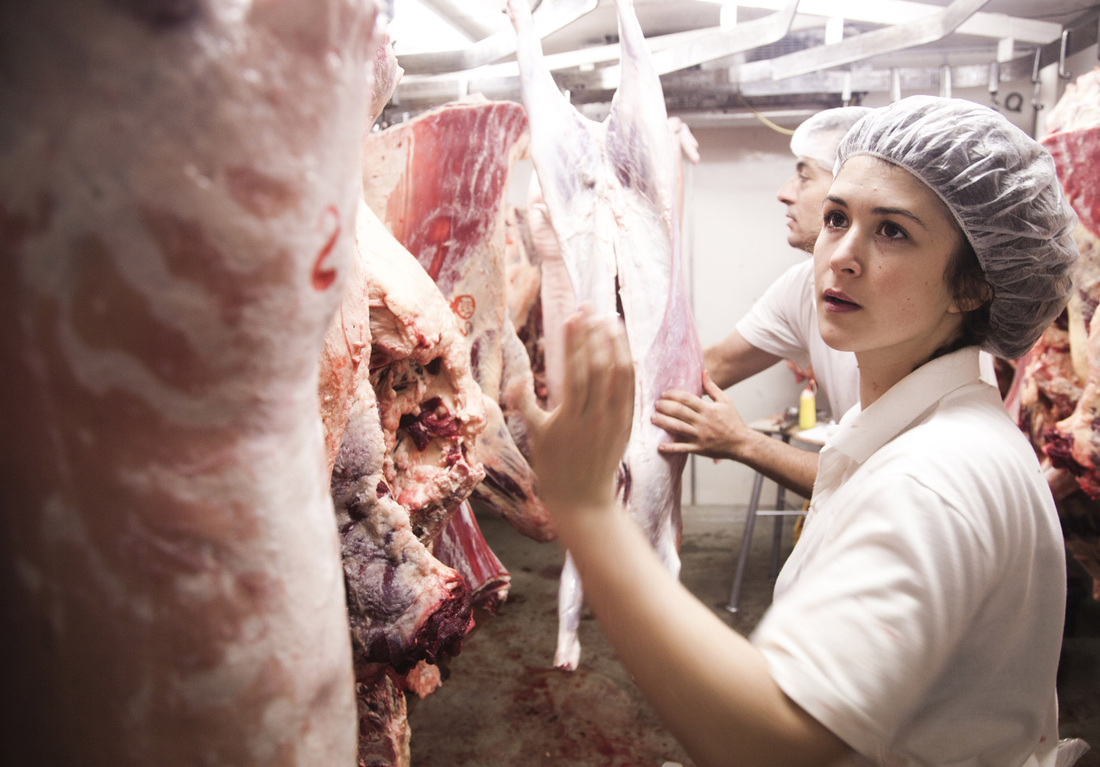
It would please me if the joke didn't work because it was neither surprising nor distasteful that someone killed animals for a living. It is this squeamishness about where meat comes from that is part of the reason that we accept, in ignorance, poor quality meat from supermarkets. We seem to have become scared to ask too much about how and where it was killed, and how it was cared for before it was killed.
We have allowed ourselves to become distanced from meat production by both literal distance and by the plastic wrapping that makes a single joint of meat look like that is how it always was - neatly packaged, sat on a polystyrene tray in a fridge.
Not that it's easy to find out where your meat was killed. Despite the law saying we must have absolute traceability for meat, it is virtually impossible for the consumer to track a piece of meat back to the farm it was reared on, believe me, I've tried. You can at best find the identification number of the abattoir it was killed at, and if you Google that number you will usually find out that supermarket meat comes from a huge factory style abattoir miles away from the store you bought it at.
I confess to having started this blog in a state of ignorance about meat. Ignorant but curious. I'm tired of the sense that the gloss of supermarket shopping doesn't stand much scrutiny, and that the shiny marketing is disingenuous about my food's origins.
I didn't know the difference between good and bad meat. I didn't know that you could tell how an animal had been reared by the appearance of the meat. I didn't know that meat should be allowed to hang for a period to allow it to develop flavour and mature.
(this is a picture of the finest Wagyu beef, with thanks to British Wagyu Breeders Assoc.)
Having learnt a bit more about it I set to asking supermarket staff a little more about what I was buying. It is clear that some meat labelled 'Finest' or 'Taste the Difference', to use Tesco's and Sainsbury's labels, is better quality meat; but according to people who know about meat this isn't special meat, this is just how meat should be if it has been reared properly. So if that is Finest, what is the rest of the meat like? Well the answer seems to be that most of it is intensively farmed, indoors, fed on pelleted feed rather than grass, or grass based feeds.
I was once told by a meat counter employee that meat I was looking at was killed 'not far away', but I could see he was scrabbling around for an answer that was vague enough for him to get away with it. I got him to give me the label of the plastic wrapped sirloin of beef he had taken out of the fridge. I later learnt it was killed and wrapped in plastic in Bodmin, Cornwall, I was talking to him in a store in Oldham, Lancashire.
Yet once again, away from the supermarket, we find that there is a world of skilled people who take a great deal of pride in their work: in the way animals are cared for, and in the way they are dealt with when they are killed.
I buy meat from two butchers: Albion Farm (meat killed at John Penny Meats), and Pattinsons Family butcher (meat killed at Hartshead Meats). They are the antithesis of supermarket meat buying. They are happy to talk about where the meat they sell comes from, right down to the farm in many cases. They are eager to share with you their views on how animals should be handled and cared for up to the point of death and equally eager to talk about how their bodies should be respected and treated as food.
If you'd like to more about the John Penny's abattoir read food critic Jay Rayner's account of his visit to witness the killing of an animal first hand.

This photo of Albion Farm Shop & Cafe is courtesy of TripAdvisor
As I learn more about food, the single most important lesson is that the being able to talk openly and honestly about the food you are thinking about buying is the key to getting the best value. If you cannot have that relationship with your butcher, don't buy meat from them.
I once asked the closest high street butcher to my house for a free range chicken. He struggled not to scoff and joked that the chickens sat in his refrigerated display were free to go anywhere they wanted. I didn't buy anything from him then, nor have I since.
The best meat is to be had at good butchers, but it's not always easy to spot the good from the bad. The Q Guild organisation is not a bad rule of thumb, but if like me you are learning about what makes good meat, and learning that you can get good everyday value in better meat other than shopping the 'value' range in supermarket fridges, simply judging with your own eyes and ears when you ask questions of a butcher will tell you a lot.
In future posts I hope to show you that you can get much better value by shopping at smaller independent retailers than by sticking to the supermarket giants. It is often better and healthier to ask your butcher to recommend cheaper cuts of meat for a particular purpose then assume the bright red 'value' mince beef in the supermarket is the best value and best quality you can afford.

No comments:
Post a Comment